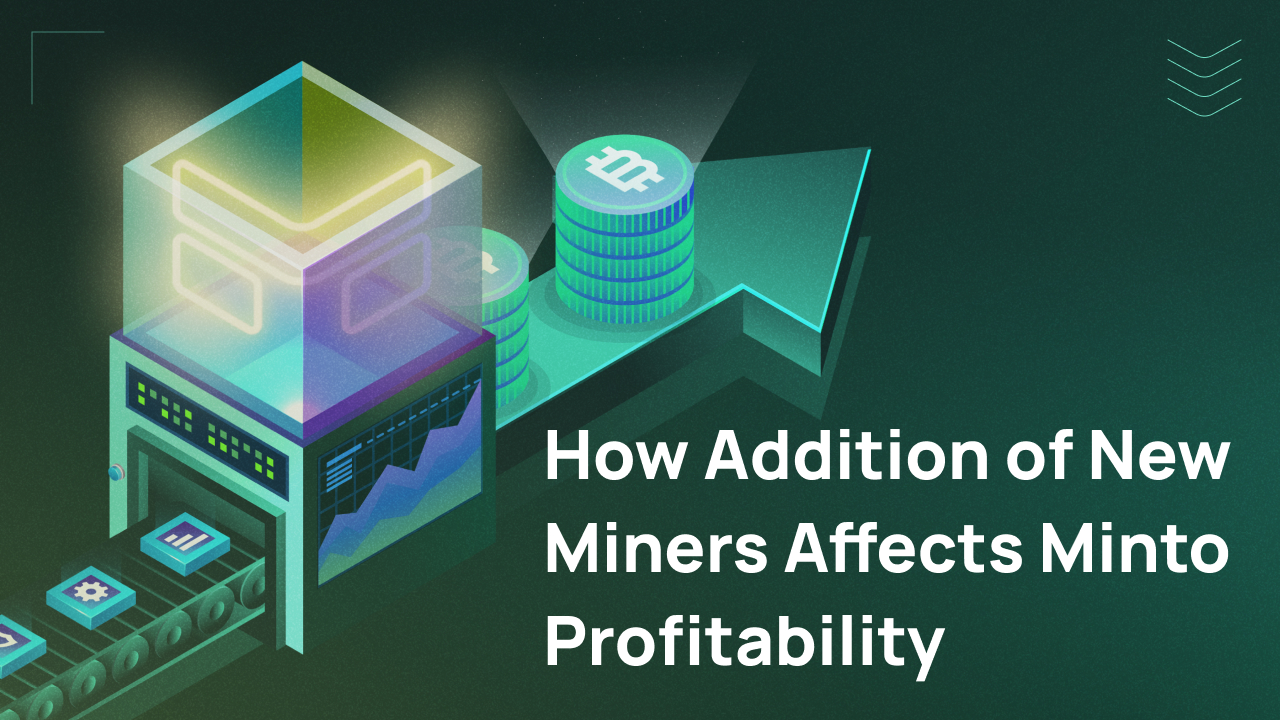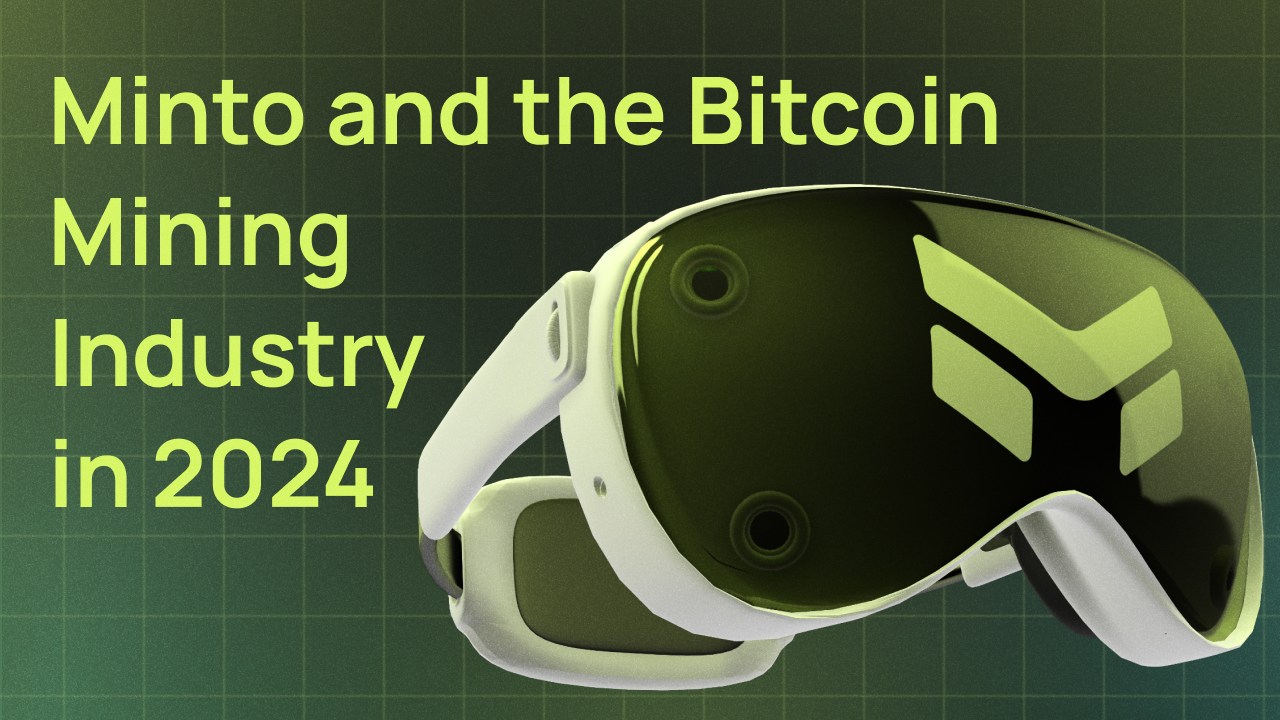Minto picks a good time to tokenize new hashrate
In December, Minto tokenized 5P of Bitcoin mining power twice. Thus, the total project hashrate has reached 65P, and energy efficiency - 57.2W/T. Flexible energy efficiency improvement is dictated by the market realities and mining hardware development.
In order to move away from the 60W/T energy efficiency originally laid down in the project, Minto held a community vote on revising this norm. After a vote, Minto made changes to its Whitepaper and immediately began to implement them. The updated WP documents Minto's new approach to mining capacity tokenization, which allows the overall project energy efficiency to remain within 60W/T, and to be improved if possible. This occurred on December 13 and 31.
Let's take a closer look at how changes in hashrate and energy efficiency affect project profitability.
To estimate the income in BTC, we use the well-known formula:
N = (t*R*H) / (D*2^32), where
N - income in BTC
t - mining period in seconds (for example, a day = 86400)
R - reward for a block in BTC (6.25)
H - hashrate (H/s)
D - difficulty (H)
So, based on the formula, the income in Bitcoins is proportional to the mining farm hashrate. When 5P was added to the already existing 55P on December 13, it increased project hashrate by a little more than 9%. Consequently, the revenue also increased 1.09-fold. Adding 5P to the existing 60P on December 31, 2022 increased revenue by 8.3% (1.083-fold). That is, just on paper the total income in December increased 1.09x1.083=1.18-fold or by 18%.
Just on paper the mining income increased by 18% in December 2022
Unlike adding hashrate, which entails a direct increase in profitability, energy efficiency (EE) affects the expenditures. By reducing the numerical EE value, we reduced the cost of mining hardware's power supply, that is, each hash of mining power will cost us less.
Let's see how energy efficiency affects profitability. We use the formula of daily costs from the Whitepaper:
Daily costs = EE х Electricity price х H х 24 х 1.03, where
EE - energy efficiency (W/H)
H - hashrate (H)
Electricity price - the cost of 1W of electricity
24 - let's estimate the daily costs, i.e. in 24 hours
1.03 - the standard loss of energy efficiency in the industry, which is 3%
On December 13, we improved energy efficiency from 60W/T to 58.5W/T, that is, by 2.5%, hence reducing electricity costs 1.026-fold. And then on December 31 we went from 58.5W/T to 57.2W/T, thus increasing it by another 2.22% (1.023-fold). Thus, in total, in December, just on paper costs decreased 1.049-fold or by 4.9%.
Just on paper the total costs decreased by 4.9% in December 2022
By combining the gain in income and the decrease in costs, we get a 1.18x1.049=1.238-fold increase in profitability, i.e. a growth of almost 24%! Thus, the seemingly small changes in mining hardware lead to a significant increase in mining profitability, especially if more energy-efficient models are added to the project every time!
Just on paper 10 PH/s of additional energy efficient mining hardware increased project profitability by 24%
The real statistics of Minto mining
Mining statistics for the week of January 8 - 14 gives us a total of 0.231 BTC, whereas in the week before the hashrate was added (December 4 - 10) - it was only 0.118 BTC. Thus, in real figures, the growth was about 95%, which is explained by the successful operation of the smart algorithm of 65% mining hardware uptime and Bitcoin difficulty fluctuations.

In view of the multiplier, which also increased by about 10% (from 2.9 to 3.2) due to hashrate growth, the profitability for BTCMT token holders (end users) increased by 117%, that is, almost 2.17-fold, over one week.
The addition of only 10 PH/s of energy-efficient hashrate ensured a 2.17-fold increase in profitability!
What's about Bitcoin miners?
Minto plans to continue to increase project hashrate by adding more energy-efficient miners and thereby ensure an increase in user profitability due to project efforts, and not only due to BTC rate growth, which is especially important in an unstable market.
Mining energy efficiency growth is a key trend of this and the next few years. As technology improves, more efficient models will gradually replace less efficient ones. The prices of outdated, but still relevant miners are already extremely low, which provides an excellent opportunity to buy them cheap. Now is a very favorable time to buy!
According to HashrateIndex, the AntMiner S19 cost about $12,000 at its peak in April 2021, while it currently fluctuates around $1,500.

Below is a comparative table of some miner models’ price dynamics over the past year and a half, as well as the cost of 100 TH/s equivalent in Minto project’s BTCMT tokens:

We can draw one very important conclusion from this table:
Mining hardware is significantly more volatile than a similar hashrate in BTCMT tokens. Prices for almost all popular miner models have dropped by 85% since the peak of interest in mining, while a conditional miner with a hashrate of 100 TH/s in BTCMT tokens (3,125 BTCMT, with a 3.2 income multiplier, which provides the 10,000 BTCMT equivalent = 100 TH/s) decreased by 67.5%. At the end of 2021, a miner in BTCMT cost 1.6 times less than the most popular Antminer S19 Pro model!
The hashrate in BTCMT tokens reflects a fairer value than popular miners during the greatest hype
Thus, an owner of hashrate in BTCMT tokens has no need to maintain physical equipment, which reduces the price risks of owning hashrate, let alone the fact that it offers maximum liquidity in tokenized form.
The price of a conditional miner in BTCMT tokens is less volatile compared to physical miners
As for the trend towards achieving better energy efficiency of mining hardware, Minto follows it to the same extent as miner manufacturers, and also carefully monitors the ratio of energy efficiency and equipment prices.
New energy-efficient miner models offered by manufacturers such as Bitmain, Canaan, MicroBT, including liquid-cooled ones, are still very expensive.
According to HashrateIndex, the price of one terahash in terms of the incoming miner price on the market was as follows:

On December 16, 2022, when buying a miner with energy efficiency better than 38 W/TH, the cost of 1 TH/s was $16.46, whereas for devices 38-68 W/TH it equaled $10.61, and for outdated devices with energy efficiency worse than 68 W/TH - only $4.72. Therefore, it is too early to expect large mining companies to dramatically upgrade their mining capacities and become more profitable overnight..
Typical miners are complex equipment that requires logistics expenditures and constant maintenance, and it becomes cheaper in a falling market much faster than benchmarks (BTC, ETH). We can say that today is the best time to buy mid-segment miners. Their prices are under pressure not only from the general state of the industry, but also from the emergence of new, more efficient models, which, although still expensive, are already prepared to become cheaper and occupy this niche.
Today is the best time to buy mid-segment miners (Miners = BTCMT tokens)
Only the shares of large American mining companies are growing cheaper faster, for example, Marathon Digital Holdings has fallen in price almost 20-fold over the year:

What's about BTCMT mining token?
BTCMT hashrate tokens are growing cheaper more slowly, since they do not require any additional maintenance costs, while consistently providing holders with daily mining income in any market situation. Tokens combine stock liquidity and the effectiveness of the best miner models, thus their stable market position.
BTCMT hashrate tokens are getting cheaper significantly slower than public mining companies’ shares

Today, enthusiasts have a choice between buying cheaper miners or cheaper mining tokens, i.e. buying and maintaining real equipment, or accumulating tokens and receiving daily passive mining income with no additional costs.
Minto is becoming an increasingly flexible mining tool, increasing the energy efficiency of its equipment fleet and project hashrate. Token liquidity is akin to the liquidity of mining companies' shares, while the liquidity of mining hardware is extremely low, and the volatility of its price is very high. There may simply be no buyer for the equipment, or it may fail, become unprofitable, etc. The equipment carries higher risks than the Minto mining token.
Minto builds its own mining infrastructure and concentrates on its high efficiency, which is why, even in such a difficult time, the company continues to pay out mining rewards and does not consider it something extraordinary. Focusing on market realities, Minto implements a consistent strategy of accumulating mining power and increasing its energy efficiency, and the price of the BTCMT token reflects both the reliability of this infrastructure and the profitability it provides.










